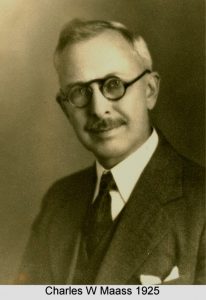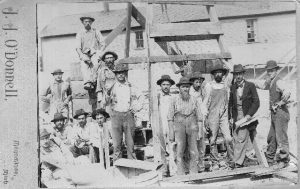by Morgan Davis.
Charles Maass (1871-1959) was the architect who worked the longest in the Copper Country during its boom years, practicing here from about 1895 until after 1920.
Biography

Charles W. Maass was born in Green Bay, Wisconsin, the oldest of thirteen children. His father had immigrated to Green Bay from Germany In 1862 and later owned a brickyard in Menominee, Michigan.1 Charles graduated from high school and worked for two Menominee architects before establishing his own firm there. He moved to the Copper Country in about 1895. Charles and his wife, Lilian, had two daughters, Frances and Grace. Charles worked as a draftsman for Calumet & Hecla from 1900 to 1909, but also seemed to be designing buildings for other clients as well.2 The 1897-98 and 1899-1900 Polk directories record him as having an architectural firm in partnership with Theodore F. Lohff in Laurium; Maass lived at the same address as the firm, on Amygdaloid Street.
Maass worked for C&H for nine years, but in about 1904 he formed a firm in partnership with his brother, Fred (1881-1959), about whom little is known. The firm’s offices were located in the State Savings Bank in Laurium. In 1907 Charles Maass announced in the newspaper that he was leaving, probably for Milwaukee.3 Whether he actually left is not known, but by 1910, he had rejoined his brother, moved to Houghton, and opened an office in the Citizens National Bank Building. The Maass Brothers had a number of school designs to their credit, including additions to the Trimountain and South Range schools in 19124 and new schools in Dodgeville, Hurontown, and Otter Lake in 1913.5 In 1912 the Maass Brothers were the only firm listed in the Copper Country. In the spring of 1913, Charles announced that he was leaving the Copper Country after eighteen years and moving to Seattle. Fred had recently moved to the Iron Range.6

Charles Maass returned soon thereafter, however. In 1914 he designed a town hall for Arvon Township in Skanee.7 Fred, meanwhile, designed a remodeling of the Laurium Village Hall that summer. In 1915 Charles applied for architectural registration in Michigan.8 In the 1916-17 directory, the Maass Brothers were the only architects listed, but they were no longer a partnership; they were listed separately. Both of them were living in Houghton. They were listed as “Maass Brothers” on the drawings for the South Range Grade School in 1918, though.9 The 1920 census listed Charles Maass as living in Houghton, but he apparently moved to Detroit soon thereafter, because 1921 drawings for the L’Anse Township School Gymnasium bear his name and an office in Detroit.10 Plans for a house for Michael Seeley in Detroit, dated 1949 and signed by Charles W. Maass, registered architect with an office in Detroit, are in the MTU Archives, indicating an exceptionally long career.11
In a questionnaire that Maass filled out in 1946, he cited, as representative of his work on buildings that cost less than $300,000, the Masonic Building in Houghton, the OddFellows Block in Houghton, and the Thomas Hoatson Residence in Laurium. For a more expensive building, he cited the Marinette County Courthouse, Marinette, Wisconsin (1941-42).12
Buildings
- Kinsman Block 1898
- Hermann Building 1898
- Fichtel House 1899
- Vertin’s Department Store 1900
- Michigan House 1905
- Charles Maass House 1905
- Jacka Block 1905
- Calumet State Bank 1906
- MacDonald House 1906
- Sibilski House 1906
- Ulseth House 1906
- Tamarack Co-operative Store 1907
- Croatian Co-operative Store 1907
- Milligan House 1907
- Lathrop House 1907
- Hoatson House 1908
- Masonic Temple of Houghton 1910
- Independent Order of Odd Fellows 1910
- Temple Jacob 1912
- Chassell High School 1912
- Laurium Village Hall 1914
- St. Anthony of Padua Convent 1915
- Quincy Mining Company Clubhouse 1917
Notes
- Eckert, Sandstone Architecture, 282. Frances Fredericks Maass, “My Family History” (1917), manuscript school paper, Keweenaw Historical Society Collection 43, Box 11, Folder 8, MTU Archives.
- 1910 and 1920 censuses. “Questionnaire for Architects’ Roster and/or Register of Architects Qualified for Federal Public Works,” May 1, 1946, American Institute of Architects Archives.
- Copper Country Evening News, 27 July 1907.
- Michigan Contractor and Builder 6, No. 2 (6 July 1912): 14.
- Michigan Contractor and Builder 7, No. 14 (19 September 1914): 8.
- Michigan Contractor and Builder 6, No. 17 (19 October 1912): 12; 6, No. 19 (2 November 1912): 15; 6 No. 29 (11 January 1913): 10; 6, No. 31 (25 January 1913): 13; 6, No. 33 (8 February 1913): 4; 6, No. 35 (22 February 1913): 5; 6, No. 42 (12 April 1913): 12; 6, No. 42 (12 April 1913): 12.
- The full text of this informative note, obviously written by Maass, reads: “Architect Charles W. Maass, for the last four years located in Houghton, has left for Seattle, Washington, with his family, and expects to make his permanent home in that city. Mr. Maass was a resident of the copper country for 18 years. He spent nine years of that time as architect in the office of the Calumet & Hecla Mining Company. He later engaged with his brother, Fred Maass, in the general practice of his profession at Laurium, and four years ago the firm moved to Houghton. Fred Maass recently located in the iron country. Mr. Maass leaves in the copper country many examples of his professional work, having done the bulk of the architecture of the district for some years past.” Michigan Contractor and Builder 6, No. 43 (19 April 1913): 15.
- Eckert, Sandstone Architecture, 282.
- Gundlach Collection, 86U, MTU Archives.
- Gundlach Collection, 86S, MTU Archives.
- In “Houses and Churches” folder, C&H Drawings collection, MTU Archives.
- “Questionnaire for Architects’ Roster and/or Register of Architects Qualified for Federal Public Works,” May 1, 1946, American Institute of Architects Archives.